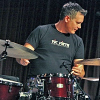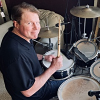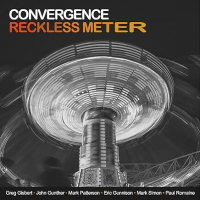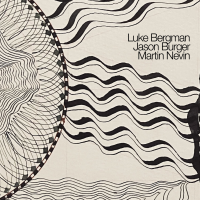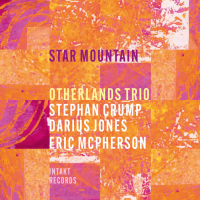Home » Jazz Articles » Album Review » Lyle Mays: Eberhard
Lyle Mays: Eberhard
Track review of "Eberhard"Mays had been largely MIA from the music scene as a performer for the past decade, but even longer when it came to recorded works. During his lifetime, Mays' own discography as a leader/co-leader ultimately amounted, beyond a small series of media scores, to just six recordings, from 1981's classic collaboration with Metheny and Brazilian percussionist/vocalist Nana Vasconcelos, As Falls Wichita, So Falls Wichita Falls (ECM Records) through the 2015 release of a German live performance, The Ludwigsburg Concert (SWR Music).
The Ludwigsburg Concert was certainly a most welcome event for fans starved for new music from Mays, whose previous release under his own name, Solo: Improvisations for Expanded Piano (Warner Bros.), dated back to 2000. Undeniably superb, Ludwigsburg featured Mays, along with a stellar group of band leaders including in-demand Los Angeles-based reed and woodwind multi-instrumentalist Bob Sheppard (Chick Corea, Chris Botti, Bill Cunliffe), double bassist Marc Johnson (Bill Evans, John Abercrombie, Eliane Elias) and drummer Mark Walker (Oregon, Eliane Elias, Paquito D'Rivera). But the two-disc set actually represented the long overdue document of a live performance that had taken place 22 years prior in November 1993, in support of Mays' then-recently released trio album, Fictionary (Geffen Records, 1993).
All of which makes the release of Eberhard such a major event, even if it consists solely of a single 13-minute piece, originally written as a tribute to renowned German bassist Eberhard Weber and first performed at the 2009 Zeltsman Marimba Festival. Weber had suffered a major stroke two years earlier, discussed at length by the bassist in a 2013 All About Jazz interview. Mays' extended composition was, then, a most timely homage to an important influence and collaborator who was still recovering and determining if he'd ever be able to play bass again (sadly, he could not).
The composition's inception began when Mays was invited to perform the closing concert at the festival, but it was not until 2019, when the pianist's health took a serious turn for the worse, that Mays finally decided to document the piece. And if the original "Eberhard" already had much of its architecture in place a decade earlier, Mays took the opportunity of the ensuing years to further hone its multiplicity of musical ideas and colors. The result is an extended work that reveals far greater complexities when examined more closely, despite flowing with the kind of apparent ease that was a cornerstone of Mays' work.
The last large-scale recording to feature Mays' writing and playing was Pat Metheny Group's studio swan song, The Way Up (Nonesuch Records, 2005). Following an intense, globe-trotting tour in support of that album, beginning in February 2005 and wrapping up, five months later, at a free outdoor concert in front of about 125,000 fans at the Festival International de Jazz de Montréal, Mays toured Europe and Japan one more time with Metheny five years later, for the unofficial (and, so far, undocumented) Songbook Tour.
Eberhard appears to be Lyle Mays' own musical swan song, one in which he was fully involved from beginning to end despite its posthumous release. Its relative brevity renders double bassist, co-producer, Metheny Group collaborator and close friend Steve Rodby's liner notes all the more upsetting, as he describes that the piece "wasn't meant to be Lyle's last piece of music, and if he'd lived longer, he had plans for more."
Still, if Eberhard is, indeed, the final contribution to come from Mays' mind, heart and soul, it's as fine a piece of music as could be hoped for by those familiar with this remarkably fertile, innovative and deceptively sophisticated composer, performer and conceptualist. For those unfamiliar, there are many fine places to begin acquaintance with Mays' oeuvre. In its paradoxical concision and expansive musical reach, however, Eberhard is as superb an entry point as any to Mays' extraordinary and exceptional body of work.
Mays' was a multidisciplinary intellect, as taken with the challenges of architecture, computer programming and musical synthesis as he was the music from which his reputation stemmed. The truth is, however, that if we are all the sum total of our life experiences and interests, then the many seemingly disparate avenues down which Mays traveled throughout his life all seem to have coalesced in the conception and ultimate realization of Eberhard.
Considered, by many, to be one of the most distinctive performers and composers of his generation, Mays' relative absence from the musical sphere for over a decade was sorely missed by many. Following that 2010 tour with Metheny, however, the pianist decided to enter musical semi-retirement, though he was far from inactive. A lifelong interest in architecture culminated in Mays designing his Los Angeles house and home studio, in addition to sister Joan's house, back in Wisconsin where he was born in late 1953. A self-taught computer programmer and music synthesist, Mays also spent some of his last decade working in the computer field, in part due to the negative shifts in the music industry that continue to be felt to this day.
In his career as a leader, Mays had long expressed a disinclination towards the kinds of logistical and physical challenges with which Pat Metheny Group regularly engaged from its late '70s inception. As he grew older and began to deal with health issues, Mays became even less interested, much to the upset of his many fans around the world.
All of this, again, rendering the release of Eberhard such a major event.
Beyond the composition itself, there are certain aspects to "Eberhard" that make it something of a stylistic sequel to Lyle Mays (Geffen, 1986), one of the most audacious and promising leader debuts in contemporary jazz. Beyond the music itself, Eberhard possesses a direct connection to Lyle Mays through the pianist's reenlistment of that album's drummer/percussionist, Alex Acuña (Weather Report, Lee Ritenour, Joni Mitchell), and Bill Frisell, whose subsequent career as a leader and in-demand guest collaborator has positioned him as one of his generation's most important guitarists, both in the realm of jazz and beyond.
Despite its relative brevity, however, "Eberhard" features an additional collection of 13 musicians, making it the largest scale recorded work of Mays' career as a leader, even if the total of 16 musicians rarely, if ever, play together. Instead, Mays treats his collaborators like a modern chamber ensemble, mixing and matching instruments as his composition's various sections demand. This is not to suggest, however, that "Eberhard" doesn't live, at least in good part, in the jazz world, with plenty of groove, interpretation and spontaneity.
Mays' use of a cello quartet draws a clear line to some of Weber's best works, including the bassist's award-winning The Colours of Chloë (ECM Recordings, 1974) and The Following Morning (ECM Recordings, 1976), as well as guitarist/pianist Ralph Towner's classic Solstice (ECM Records, 1975). Wade Culbreath contributes a variety of tuned percussion instruments, from the melancholic marimba figure that opens and closes "Eberhard" to vibraphone, xylophone, orchestral bells and tone bells. All of these instruments reflect and help to realize Mays' broader interests in extended, finely detailed classical forms, but in particular the work of Steve Reich and the traditional Balinese Gamelan music that informed the minimalist composer's early works.
Other musicians that contribute to Eberhard include Rodby (on double bass) and Jimmy Johnson (Allan Holdsworth, James Taylor), whose fretless electric bass work provides an early theme that mirrors Weber's own relatively rare predilection for using bass as a lead instrument. Bob Sheppard is the composition's primary soloist, delivering some of the composition's most uplifting, exhilarating and electrifying moments on tenor saxophone, but also contributing a variety of other reeds and flutes throughout.
Despite his own inestimable skill on electric keyboards and synthesizers, Mays also brings in Mitchel Forman (John McLaughlin, Mark Egan, Wayne Shorter) on Hammond organ and Wurlitzer electric piano. Three singers contribute the kind of wordless vocals that were not only a signature for many of Pat Metheny Group's albums, but for Weber as well, heard on his sublime Fluid Rustle (ECM Records, 1979), an album which, coincidentally, represented Frisell's first major label appearance.
Of the three vocalists, Mays' niece, Aubrey Johnson (Billy Childs, Bobby McFerrin), is featured roughly two-thirds of the way through the piece. Her voice is doubled with Culbreath's marimba, in a brief section that demonstrates Johnson's remarkable ability to accomplish complex intervallic leaps and rapid vocal gymnastics, before the percussionist takes a brief vibraphone solo that leads into Sheppard's lengthier feature.
Beyond writing this tribute to Weber, Mays' connection to the bassist was more direct. He played, alongside Weber and Pat Metheny Group's first drummer, Dan Gottlieb, on Metheny's second album as a leader, Watercolors (ECM Records, 1977), as well as appearing on one of the bassist's best albums, Later That Evening (ECM Records, 1982).
"Eberhard" also references Weber's work directly. Most notably, a repeating thematic figure, at a little over two minutes into "Eberhard," is culled from one of Weber's core melodies from "T. on a White Horse," from The Following Morning. And yet, irreverent as he is reverential to Weber, Mays injects his own propensity for melodic mathematics and complexly layered polyrhythms, reiterating the first four notes from Weber's repetitive six-note figure and moving it from straight 4/4 time to alternating bars of 6/8 and 4/8, albeit layered over Culbreath's marimba-driven minimalism, in another contrasting time signature.
Dissecting the myriad of colors, tones, timbres and textures that comprise Eberhard in detail would ultimately detract from this complex yet remarkably cohesive 13-minute journey. Suffice to say that its broad range of intersecting and coalescing thematic, chordal, atmospheric and stylistically diverse components sometimes appear clearly and discretely, but are elsewhere developed with finely honed, pointillistic detail. Ideas appear and disappear, only to reappear again, sometimes together with other concepts that also wind their way in and out of this cerebral yet, at the same time, remarkably evocative collection of multifaceted emotional expressions.
Impressionistic at times, "Eberhard" is also imbued with no shortage of greater expressionism, in particular during Sheppard's potent tenor solo. In many ways, "Eberhard" represents also the sum total of a lifetime of far-reaching musical interests. Stemming from the many musicians' contributions, of course, it's also a wonderful reminder of Mays' impressive ability to use synthesis and sampling to fashion layer upon layer of atmospheric sonics, detailed percussives and sophisticated harmonic tendencies.
"Eberhard" is also a vivid testament to Mays' remarkable skill as a pianist. Possessed of an inimitably pliant touch, Mays could be as delicate as a feather, but also firm and muscular when necessary. Despite being possessed of chops to burn, Mays never overstates or overstays either, whether waxing with spare lyricism during the composition's opening minutes or more robustly bolstering Sheppard's solo alongside Rodby, Acuña and in-demand drummer/percussionist Jimmy Branly (Carol Weisman, David Garfield, Jimmy Haslip).
At the guitarist's Ottawa, Canada gig with Gary Burton, shortly before leaving the vibraphonist to form his first Pat Metheny Group lineup with Mays in 1977, a young Metheny exuberantly described Mays as "the next Keith Jarrett." He may have never have achieved the same degree of prolificity or widespread acclaim as the older pianist, but in his broad musical methodologies and an unmistakable ability to draw music from the ether, both in the moment and across longer, more considered compositional forms like "Eberhard," Mays' musical legacy is unequivocally secure.
"Musical tour de force" is a phrase often overused and abused, but it seems like the best and only way to succinctly summarize Eberhard. A monumental swan song and most heartfelt tribute to Eberhard Weber, "Eberhard" pays homage to the bassist's body of work while being something of which only Mays could conceive. Fans may have hoped for more music to come from the pianist, but in just 13 relatively short minutes, Eberhard will, no doubt, be remembered as one of Lyle Mays' crowning achievements.
Track Listing
Eberhard.
Personnel
Lyle Mays
keyboardsBob Sheppard
saxophone, tenorMitchel Forman
keyboardsSteve Rodby
bass, acousticAlex Acuña
percussionJimmy Branly
drumsBill Frisell
guitar, electricAubrey Johnson
vocalsRosana Eckert
vocalsGary Eckert
vocalsAdditional Instrumentation
Lyle Mays: piano, keyboards, synthesizers; Bob Shepard: saxophone and woodwinds; Steve Rodby: double bass; Jimmy Johnson: electric bass; Alex Acuña: drums, percussion; Jimmy Brady: drums, percussion; Wade Culbreath: vibraphone, marimba; Bill Frisell: guitar; Mitchel Forman: Hammond B3 organ, Wurlitzer electric piano; Aubrey Johnson: vocals, featured; Rosana Eckert: vocals; Gary Eckert: vocals; Timothy Loo: cello, principal: Erika Duke- Kirkpatrick: cello; Eric Byers: cello; Armen Ksajikian: cello.
Album information
Title: Eberhard | Year Released: 2021 | Record Label: Self Produced
Tags
PREVIOUS / NEXT
Support All About Jazz
 All About Jazz has been a pillar of jazz since 1995, championing it as an art form and, more importantly, supporting the musicians who make it. Our enduring commitment has made "AAJ" one of the most culturally important websites of its kind, read by hundreds of thousands of fans, musicians and industry figures every month.
All About Jazz has been a pillar of jazz since 1995, championing it as an art form and, more importantly, supporting the musicians who make it. Our enduring commitment has made "AAJ" one of the most culturally important websites of its kind, read by hundreds of thousands of fans, musicians and industry figures every month.








